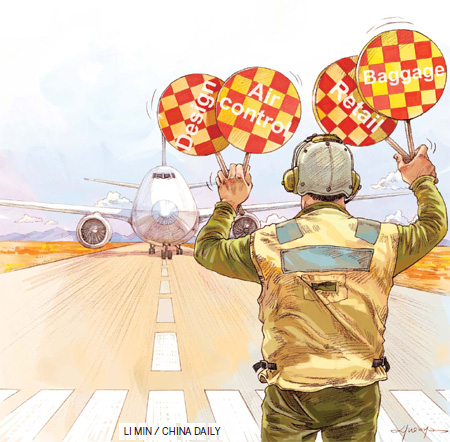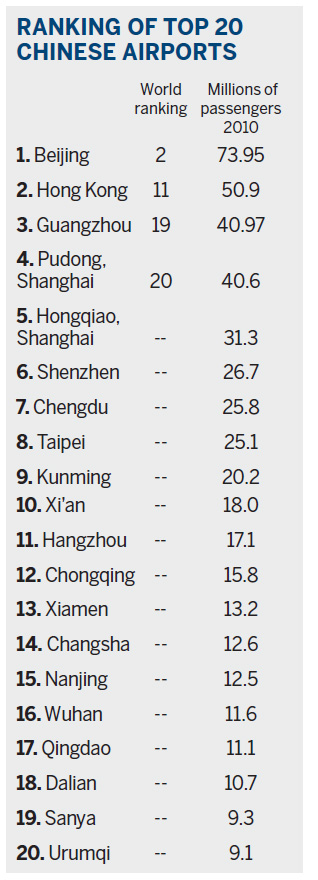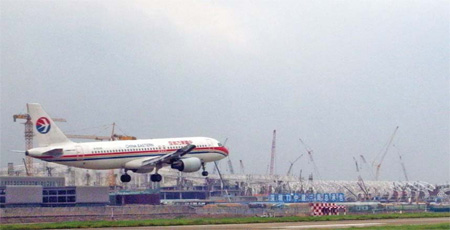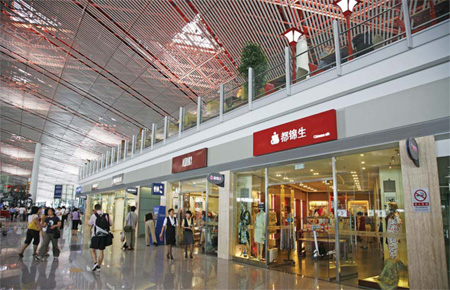Ready for takeoff
Updated: 2011-10-14 08:42
By Meng Jing (China Daily)
|
|||||||||

|
|
Foreign firms step in as Chinese airports chart modernization path
Though air travel is booming in China, only a handful of the airports are actually in the black. But with China planning to invest some 1.5 trillion yuan ($236 billion, 174 billion euros) over the next five years to develop infrastructure at its airports, fortunes could change for many of them even as multiple windows of opportunity open for foreign companies to cash in on.
Between 2006 and 2010, nearly 250 billion yuan of the total outlay of 1 trillion yuan for the aviation sector in China was spent on infrastructure construction, including 33 new airports and improved facilities at over 142 airports, according to the Civil Aviation Administration of China (CAAC).
Under the 12th Five-Year Plan (2011-2015), China plans to expand as many as 91 of its existing 175 airports, while 56 new ones have been planned and 16 earmarked for relocation.
Though higher revenue is the prime objective of the airport modernization program, it draws on the desire of many Chinese airports to become major global transshipment hubs for passengers and cargo replete with facilities that outstrip major Western airports.
| ||||
But for overseas investors, it is the big retail push unleashed by these programs and the need for technology solutions that offer the most promise.
With China becoming the biggest luxury market in the world, the expansion plans open up the booming domestic retail market for a host of foreign companies and brands. At the same time foreign companies can also look for other retail opportunities as Chinese airports metamorphose into airport city models for sustained revenues.
The airport city model is based on the concept that airports can do more than the traditional aeronautical services, by evolving new non-aeronautical commercial facilities. Airport city models can be best illustrated by the success story of the Amsterdam-based Schiphol Airport.
Wang Jian, secretary general of the China Civil Airports Association, says that many cities and gateway airports in China are moving in a similar direction. "It is a big opportunity for Western companies. They have got several decades of experience. What we don't have and don't know is the business potential," Wang says.
"In Amsterdam, people go to the airport using trains and other means just for shopping. The airport has lots of nice shops and restaurants, and a host of office buildings in which several people work, making the whole facility an integrated one," says De Haas Albert, the transport and water counselor at the Netherlands Embassy in China.
Haas says that though China has several airports with shops, none of them are airport cities yet.
"The proposed second international airport in Beijing has plans to be an airport city. Right now it is still on paper and all you will see is just the corn. But in five years, who knows," he says.
Of the world's leading 500 global luxury brands, over 70 percent are present in China and looking to grow further, according to industry estimates. Prominent among them are big-ticket brands like Giorgio Armani, Jimmy Choo, Cartier, Tod's, Dior, Fendi, Burberry, Hugo Boss, DKNY, Ravissant and Louis Vuitton.
What makes the airport pitch interesting for many of the companies is the relative infancy of luxury brands at major Chinese airports. Though some of the brands have a fledgling presence in some airports such as Beijing and Shanghai, none of them can boast of the kind of shelf or store space they enjoy in airports such as Hong Kong and Kuala Lumpur.
With wealthy Chinese being the major shoppers at many leading international airports, the brands are now looking to boost their clientele in China. For many of them an airport presence is the easiest ticket for market entry in China
Three and a half years and 27 billion yuan after it dazzled the world with its glitzy and spanking new airport terminal, the Beijing Capital International Airport (BCIA) is now finding that it needs to desperately augment its existing facilities as it is bursting at the seams from heavy passenger inflows.
The terminal is equipped with a 1.8 billion yuan baggage handling system (BHS) from German conglomerate Siemens AG, which is co-designed by renowned British architect Roman Foster and Dutch airport consultancy firm NACO at an estimate cost of more than 100 million yuan. Though it was supposed to reach its designated capacity of 82 million passengers in 2016, going by the current numbers it is likely that the target may be breached sometime next year.
While the impending overcapacity is certainly not good news for BCIA, it is sweet music for global companies, as plans to build a second international airport in Beijing are currently underway.
Though no official budget has been announced for the proposed Beijing New International Airport, the mega airport with seven runways (four more than BCIA) and a capacity of handling up to 100 million passengers every year has already made it to the list of "must-have-projects" for major players in the global aviation industry.
Li Xiaojin, a professor with the Tianjin-based Civil Aviation University of China, says that such bold infrastructure plans are indeed viable as air traffic in China is galloping at a fast pace. He says passenger movements by flights nearly doubled to 268 million in 2010 from 2005 levels. "Some 26 airports in China are facing overcapacity problems. Not only do they need more flights for passengers, but in many cases more runways for flights," Li says.
Jeffrey Wong, a partner of the global consultancy major KPMG and the transport and logistics sector leader for China, also says that an increasing number of domestic airports will face capacity challenges because of the booming economy and the surging middle class.
China's gross domestic product (GDP) grew 10.3 percent in 2010, the fastest in three years, helping the nation surpass Japan as the world's second largest economy. "Continued economic growth and a rising middle class in China is expected to spur rapid traffic growth at the nation's airports in the years to come," Wong says.
CAAC is forecasting an 11 percent growth in passenger movement by 2015 to 450 million. By 2020, the top aviation sector planner expects passenger numbers to surpass 1.5 billion.
HITT, a Netherlands company that provides air traffic management and navigation systems to airports, has already been one of the beneficiaries of the impending boom.
Richard Li, sales engineer at HITT, says that after his company sold an air traffic system in Shanghai in 1998, it sold only one more system to the Beijing Capital International Airport in 2000 before riding the current boom when it sold five systems in 2010.
Richard Li, sales engineer at HITT, says that after his company sold an air traffic system in Shanghai in 1998, it sold only one more system to the Beijing Capital International Airport in 2000 before riding the current boom when it sold five systems in 2010.
HITT's radar system tracks the movement of aircraft and landside vehicles, and can help air traffic controllers minimize accident risks, especially in adverse weather conditions. "It is a niche market, because the system is necessary only for airports with a passenger output of 8 million a year or for those with two runways," Li says.
Size is often an issue that confronts international aviation companies in China as most of the target airports for investment are of a certain size, and capable of handling around 8 to 10 million passengers a year. "Most of the feeder airports and those with small passenger flows don't need and can barely afford top-notch equipment from international companies," he says.
Of the 175 airports in China, nearly 21 accommodated more than 8 million passengers in 2010, compared with just eight airports in 2005. Despite the current small size, the outlook is rosy. Over the next 20 years, China's passenger air traffic is expected to grow by 7.7 percent every year, compared with the global average of 5.2 percent.
"China is an important emerging market for HITT. Most of the Western markets have matured and the current sluggish financial scenario is proving detrimental for major infrastructure spending in Europe," he says. But Li says his company is confident of posting solid business in China over the next five years.
Most of the optimism in China comes from companies that provide BHS services such as the Germany-based Siemens and the Netherlands-based Vanderlande Industries. BHS is an integral element for any major hub airport and also the biggest equipment investment in a new terminal.
Siemens' 1.8 billion yuan BHS contract with Beijing Capital International Airport is an example of this, as the equipment costs account for nearly 10 percent of the total investments on Terminal 3. The system can sort and transport 19,200 pieces of baggage per hour.
The faster the system operates and more reliably sorts the bags of transfer passengers, the shorter is the so called "minimum connecting time", a key performance indicator for airports.
With the surge of passenger output in China, more and more airports, especially hub airports, are choosing international BHS suppliers for their new terminals to avoid baggage delays and other sorting issues. For instance, the Xi'an Xianyang International Airport (XXIA) in Northwest China has chosen Siemens' BHS for its terminal three which is scheduled to open in March next year.
"Our Terminal 1 with a designed capacity of 2 million passengers uses the old manual baggage sorting system even now, while Terminal 2 with a design capacity of 7.5 million uses a semi automatic system from Japan," Zhang Wenge, general manager of XXIA, says.
"The new terminal will boost our passenger capacity to 31 million. With the expected rise in baggage throughput, we have to turn to automated baggage handling systems. So the options narrow down to only a handful of qualified equipment suppliers from the West," he says.
Vanderlande Industries' sales performance in China also demonstrates the fact. The heavy investment in airport construction in China has helped boost the Dutch company's annual revenue in China from 10 million yuan before 2006 to 200 million yuan during the 11th Five-Year Plan (2006-2010).
Ben Xia, managing director of North Asia with Vanderlande Industries, says BHS sales are expected to rise in the next five years, even though most of the airport projects are small. "At least 11 of China's regional hub airports will be expanded in the next five years, and that offers many opportunities for companies like ours," Xia says.
Vanderlande's BHS is currently deployed across 16 airports in China, a small slice compared with the 500 airports it handles globally.
But Xia says that the company looks to China with an eye on the future. "The number of airports in China that have decent baggage handling system is just 30 to 40. That itself shows that there are several opportunities ahead," he says.
There is no doubt that China is becoming a money machine for international airport equipment suppliers, especially those with cutting edge technology. But for infrastructure construction, a market that is not quite open in China, money is not the only factor that motivates international firms.
Companies like the Netherlands-based NACO, an airport consultant that has presence in more than 600 airports around the world, are turning to China for the goodwill and reputation it gets from such deals.
The company, which beat three other international firms to win the master plan competition for the Beijing New International Airport (BNIA) earlier this year, says its actions were not motivated by the $300,000 design compensation.
Cai Jinshan, chief representative of NACO in China, says the company did not gain monetarily from the deal as it took several months of efforts by Dutch experts to come up with the winning design and also involved travel expenditure. Though the returns were meager, they are keen on participating in the next scheme design competition for a new terminal at the BNIA.
"It is not only about the 13 million yuan design compensation. We believe the airport has the possibility to become the largest airport in the world. That is the kind of project we'd like to be associated with," says Cai.
He says that the BNIA is similar in scale to mega airports in other countries, such as the Suvarnabhumi Airport in Bangkok and the Dubai International Airport. "They are all fancy mega airports, but we believe BNIA is the only one that has the possibility to actually become the largest airport in the world, given China's economy and huge population," he says.
Nearly 3 to 5 percent of NACO's revenues for 2010 came from China, compared with 35 percent from its home turf in the Amsterdam Schiphol Airport and 30 percent from the Middle East.
Cai says that foreign design firms are usually not allowed to participate in the follow-up engineering stages of airport projects and that also is the main reason for lower revenues from China.
"Chinese engineering companies are quite good and it is difficult for foreign companies to be involved in the engineering stage due to license problems and certain other market barriers," Cai says.
"Companies are in demand if they have successfully participated in major projects in China. The China experience not only makes our portfolio look good, but helps us bag orders in other nations," he says.
But mega projects such as BNIA aren't going to show up in China frequently despite a dramatic passenger forecast of 1.5 billion by 2015.
In fact, Jeffrey Wong from KPMG says that the airport construction spree in China will start to cool down after 2015 with more and more airports beginning to optimize current facilities and maximize the usage based on existing resources.
That, however, does not mean that the door for international aviation companies is about to close in China. With more airports striving to become modern, several opportunities exist for firms that provide technology solutions.
Shane Tedjarati, president and CEO of Honeywell China and India, says passengers are more savvier and demanding in their experiences.
The company, which recently formed a new department offering turnkey solutions for running airports, anticipates huge business potential in China. "Complexity - not only in infrastructure but also in operations are major concerns for airports. Honeywell has the expertise and technology to offer modernized solutions for airports to deal with these issues," he says.
At London Heathrow, for example, the terminal buildings are created as self-sufficient hubs that can cater to a mass of passengers contained in an enclosed space for a minimum of two hours.
"I believe as airports in China become more sophisticated and modern, airport managers will increasingly appreciate intelligent airport solutions that companies like Honeywell can bring to the table," he says.
|
A China Eastern airplane takes off at the Shenzhen airport, which is undergoing expansion. China plans to expand 91 airports, while 56 new ones have been planned and 16 earmarked for relocation during the 12th Five-Year Plan. Zhou Haijun / for China Daily |
|
Shops at Beijing airport's Terminal 3. China's airport construction will open up retail opportunities for foreign firms. Zhang Kaixin / for China Daily |

(China Daily 10/14/2011 page1)















